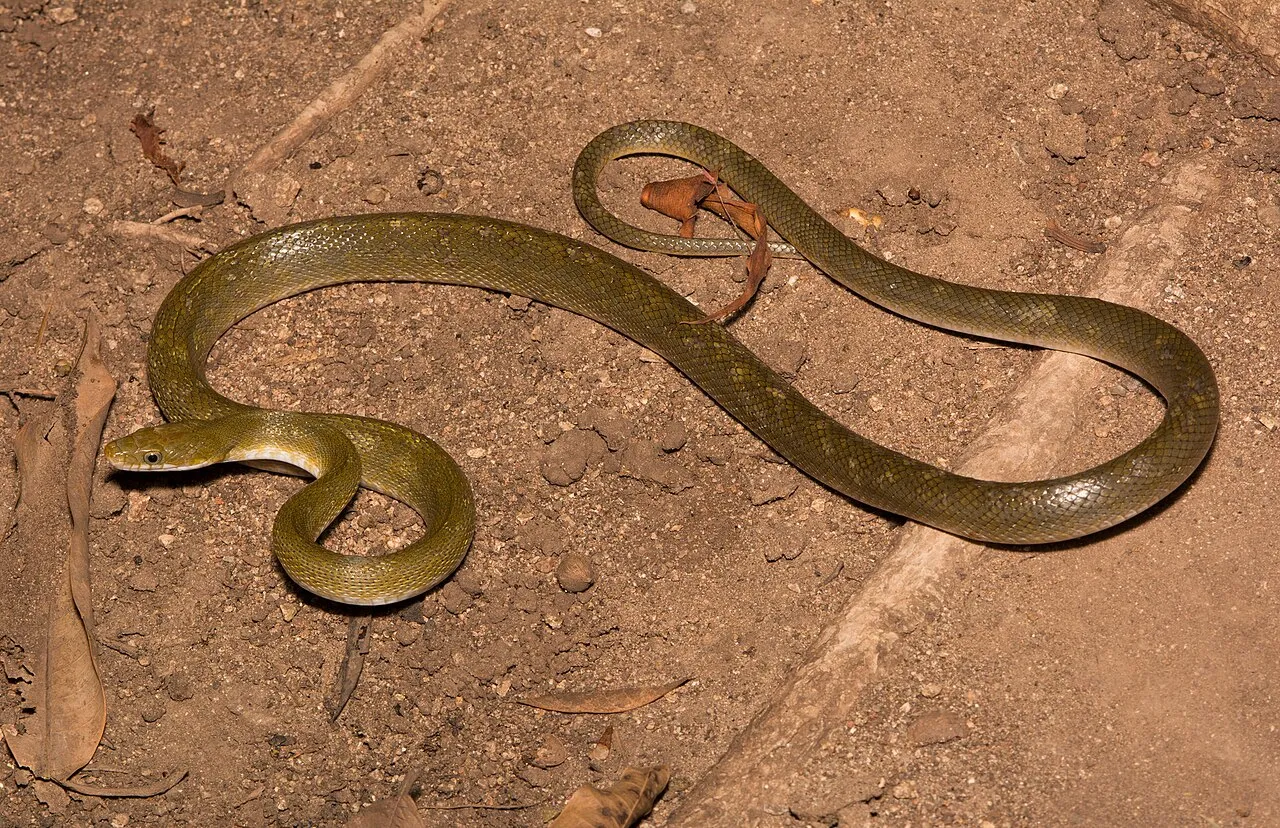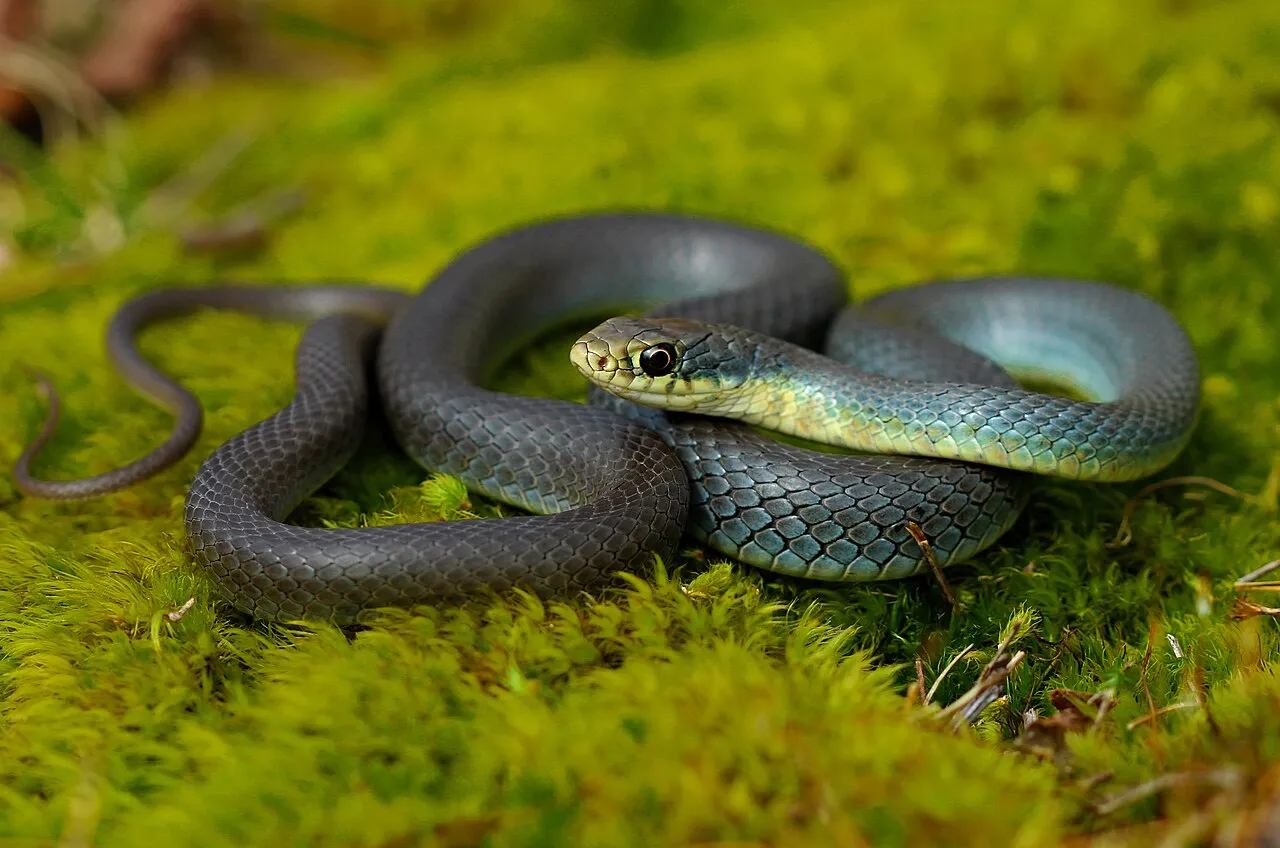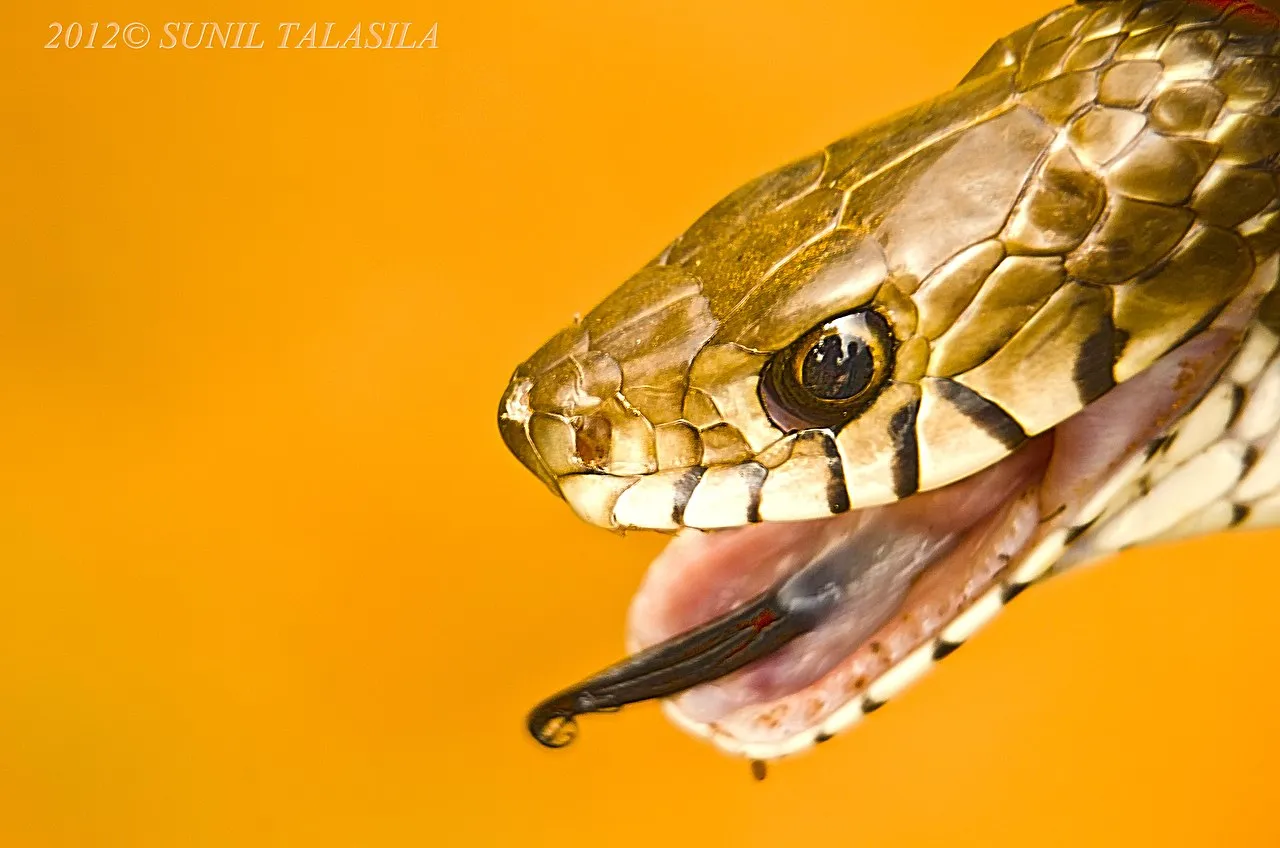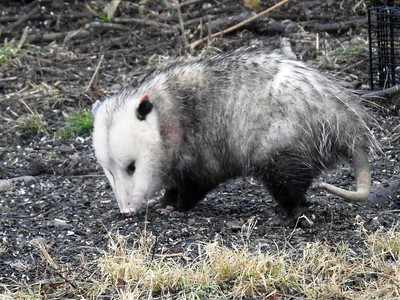9+ Non Venomous Snakes In Tennessee And Their Characteristics
Examples of non-venomous snakes in Tennessee are the Eastern Rat Snake, Eastern Garter Snake, Eastern Hognose Snake, Black Rat Snake, Corn Snake, Rough Green Snake, Eastern Ribbon Snake, Eastern Milk Snake, Eastern Coachwhip, and Northern Water Snake.
1. Eastern Rat Snake (Pantherophis alleghaniensis)
The Eastern Rat Snake, also known as the Black Rat Snake or simply Rat Snake, is a common non-venomous snake species found in Tennessee. They belong to the Pantherophis genus and are native to North America. These snakes are relatively large, with adults typically reaching lengths between 3 to 6 feet, although some individuals may grow even larger.
In Tennessee, Eastern Rat Snakes can be found in a variety of habitats, including forests, fields, marshes, and suburban areas. They are excellent climbers and are often observed climbing trees and shrubs in search of prey, which primarily consists of rodents, birds, and their eggs. Rat Snakes are constrictors, meaning they subdue their prey by wrapping around them and squeezing until they suffocate.
Eastern Rat Snakes play a crucial role in controlling rodent populations, making them beneficial to ecosystems and potentially to human populations as well. Despite their beneficial role, they are sometimes mistaken for venomous species like Copperheads due to their similar coloration and pattern. However, Rat Snakes can be distinguished by their slender bodies, round pupils, and lack of heat-sensing pits, which are characteristics of venomous pit vipers.
2. Eastern Garter Snake (Thamnophis sirtalis sirtalis)
The Eastern Garter Snake is another common non-venomous snake species found throughout Tennessee. It is a member of the Garter Snake genus, Thamnophis, which includes several species distributed across North America. Garter Snakes are relatively small, typically ranging from 1 to 3 feet in length, with females generally being larger than males.
In Tennessee, Eastern Garter Snakes inhabit a variety of habitats, including grasslands, meadows, forests, and wetlands. They are highly adaptable and can also be found in urban and suburban areas. Garter Snakes are known for their distinctive coloration, which includes longitudinal stripes running along their bodies, usually in combinations of green, brown, yellow, or orange.
These snakes are primarily carnivorous and feed on a variety of prey, including earthworms, amphibians, small rodents, insects, and fish. Despite their relatively small size, Eastern Garter Snakes are efficient predators and play a significant role in controlling populations of pests such as slugs and insects.
Eastern Garter Snakes are docile and rarely pose a threat to humans. When threatened, they may release a foul-smelling musk as a defense mechanism or feign death by remaining motionless. They are also known for their ability to tolerate cold temperatures, making them one of the first snake species to become active in the spring and one of the last to go into hibernation in the fall.
3. Eastern Hognose Snake (Heterodon platirhinos)
The Eastern Hognose Snake, also known as the Puff Adder or Spreading Adder, is a unique non-venomous snake species found in Tennessee. It belongs to the Hognose Snake genus, Heterodon, which includes several species native to North America. Eastern Hognose Snakes are characterized by their distinctive upturned snouts, which they use to dig for prey.
In Tennessee, Eastern Hognose Snakes can be found in a variety of habitats, including forests, fields, and sandy areas. They are particularly well adapted to sandy habitats where they can bury themselves to hide from predators and ambush prey. These snakes primarily feed on amphibians, especially toads, which they are well-equipped to consume due to their specialized rear-fanged teeth.
Eastern Hognose Snakes are known for their elaborate defensive behaviors. When threatened, they may flatten their bodies, hiss loudly, and strike with a closed mouth in an attempt to intimidate predators. If these displays fail to deter a threat, they may roll onto their backs and play dead, even emitting a foul-smelling odor to further convince predators of their demise.
Despite their intimidating defensive behaviors, Eastern Hognose Snakes are harmless to humans. They are considered beneficial due to their diet, which includes pest species such as toads and small rodents. However, like many snake species, they face threats from habitat loss, road mortality, and persecution by humans.
4. Black Rat Snake (Pantherophis obsoletus)

The Black Rat Snake, also known simply as the Rat Snake, is a non-venomous snake species found in Tennessee. It is closely related to the Eastern Rat Snake and belongs to the Pantherophis genus. Black Rat Snakes are large snakes, with adults typically reaching lengths between 3 to 6 feet, although individuals over 7 feet have been recorded.
In Tennessee, Black Rat Snakes inhabit a variety of habitats, including forests, fields, rocky outcrops, and suburban areas. They are excellent climbers and are often observed scaling trees and buildings in search of prey, which primarily consists of rodents, birds, and their eggs. Like other Rat Snakes, they are constrictors, relying on constriction to subdue their prey.
Black Rat Snakes are characterized by their shiny black scales, which may have faint traces of lighter markings when young but typically darken with age. Their scales are smooth and glossy, contributing to their striking appearance. Despite their intimidating size, Black Rat Snakes are generally docile and non-aggressive towards humans.
These snakes play an important role in controlling rodent populations, making them beneficial to both natural ecosystems and human interests such as agriculture. However, like many snake species, they face threats from habitat loss, road mortality, and persecution by humans. Conservation efforts aimed at preserving their habitats and mitigating human-snake conflicts are essential for ensuring the continued survival of Black Rat Snakes in Tennessee.
5. Corn Snake (Pantherophis guttatus)
The Corn Snake, also known as the Red Rat Snake, is a non-venomous snake species found in Tennessee. It is a member of the Pantherophis genus, which also includes the Eastern Rat Snake and Black Rat Snake. Corn Snakes are popular among reptile enthusiasts for their docile nature, attractive coloration, and ease of care in captivity.
In Tennessee, Corn Snakes inhabit a variety of habitats, including forests, fields, and abandoned buildings. They are particularly common in agricultural areas where they prey on rodents that are attracted to grain stores. Corn Snakes are excellent climbers and can often be found in trees and shrubs in search of prey or shelter.
Corn Snakes exhibit considerable variation in coloration and pattern, with individuals commonly displaying vibrant shades of orange, red, brown, and black. Their dorsal pattern typically consists of large blotches or saddles bordered by darker pigmentation, giving them a distinctive appearance. This variability in coloration has led to the development of numerous morphs in captivity, which are prized by reptile enthusiasts.
In addition to their role in controlling rodent populations, Corn Snakes are also important prey items for predators such as birds of prey, raccoons, and larger snakes. Despite their popularity in the pet trade, Corn Snakes are also found in the wild throughout their range in the southeastern United States, including Tennessee.
Conservation efforts aimed at preserving their natural habitats and reducing threats such as habitat loss and road mortality are essential for ensuring the continued survival of Corn Snakes in Tennessee. Additionally, responsible captive breeding practices can help alleviate pressure on wild populations and contribute to the long-term sustainability.
6. Rough Green Snake (Opheodrys aestivus)
The Rough Green Snake is a non-venomous snake species found in Tennessee. It belongs to the Opheodrys genus and is known for its bright green coloration, slender body, and arboreal lifestyle. Rough Green Snakes are typically found in forested areas, especially near bodies of water, where they feed primarily on insects and spiders.
7. Eastern Ribbon Snake (Thamnophis sauritus)
The Eastern Ribbon Snake is a non-venomous snake species found in Tennessee. It is a member of the Garter Snake genus, Thamnophis, and is characterized by its long, slender body and distinctive striped pattern. Ribbon Snakes are semi-aquatic and are often found near ponds, streams, and marshes, where they prey on amphibians and small fish.
8. Eastern Milk Snake (Lampropeltis triangulum triangulum)
The Eastern Milk Snake is a non-venomous snake species found in Tennessee. It belongs to the Kingsnake genus, Lampropeltis, and is known for its striking coloration, which includes reddish-brown blotches bordered by black and white bands. Milk Snakes are typically found in a variety of habitats, including forests, fields, and rocky outcrops, where they feed on small mammals, reptiles, and amphibians.
9. Eastern Coachwhip (Masticophis flagellum flagellum)
The Eastern Coachwhip is a non-venomous snake species found in Tennessee. It is a member of the Coachwhip genus, Masticophis, and is characterized by its long, slender body and whip-like tail. Coachwhips are fast-moving snakes that are often found in open habitats such as grasslands, where they prey on lizards, small mammals, and birds.
10. Northern Water Snake (Nerodia sipedon)
The Northern Water Snake is a non-venomous snake species found in Tennessee. It belongs to the Water Snake genus, Nerodia, and is well adapted to aquatic environments. These snakes are commonly found near bodies of water such as streams, rivers, and ponds, where they feed on fish, amphibians, and aquatic invertebrates.
| Snake Species | Description |
| Eastern Rat Snake |
Large, non-venomous snake known for its climbing ability and role in controlling rodent populations.
|
| Eastern Garter Snake |
Small, harmless snake with distinctive longitudinal stripes, found in various habitats including grasslands and forests.
|
| Eastern Hognose Snake |
Unique snake with an upturned snout, known for its elaborate defensive behaviors and diet primarily consisting of amphibians.
|
| Black Rat Snake |
Large snake with shiny black scales, often mistaken for venomous species due to its appearance, but harmless to humans and beneficial for controlling rodent populations.
|
| Corn Snake |
Popular among reptile enthusiasts for its docile nature and vibrant coloration, commonly found in agricultural areas where it preys on rodents.
|
| Rough Green Snake |
Arboreal snake with bright green coloration, primarily feeds on insects and spiders in forested areas.
|
| Eastern Ribbon Snake |
Long, slender snake found near water bodies, preys on amphibians and small fish, characterized by its striped pattern.
|
| Eastern Milk Snake |
Strikingly colored snake with reddish-brown blotches bordered by black and white bands, found in various habitats and feeds on small mammals, reptiles, and amphibians.
|
| Eastern Coachwhip |
Fast-moving snake with a whip-like tail, commonly found in open habitats such as grasslands where it preys on lizards, small mammals, and birds.
|
| Northern Water Snake |
Aquatic snake well adapted to water environments, commonly found near streams, rivers, and ponds, feeding on fish, amphibians, and aquatic invertebrates.
|
*FAQs about non-venomous snakes in Tennessee
Q: Are non-venomous snakes dangerous to humans? A: No, non-venomous snakes pose no threat to humans. They are typically harmless and play important roles in ecosystems by controlling pest populations.
Q: What should I do if I encounter a non-venomous snake in my yard? A: Remain calm and give the snake space. Most non-venomous snakes will move away on their own if left undisturbed. If necessary, you can gently encourage the snake to move along by creating vibrations or using a broom.
Q: How can I differentiate between venomous and non-venomous snakes? A: Venomous snakes in Tennessee, such as Copperheads and Timber Rattlesnakes, typically have triangular heads, vertical pupils, and heat-sensing pits between their eyes and nostrils. Non-venomous snakes, on the other hand, have slender bodies, round pupils, and lack heat-sensing pits.
Q: Are non-venomous snakes beneficial to the environment? A: Yes, non-venomous snakes play important roles in ecosystems by controlling populations of rodents and other pests. They also serve as prey for various predators, contributing to the overall balance of the ecosystem.
Q: Can non-venomous snakes be kept as pets? A: Yes, many non-venomous snake species, such as Corn Snakes and Ball Pythons, are popular choices for reptile enthusiasts. However, it’s important to research their care requirements and ensure that they are obtained from reputable sources.












